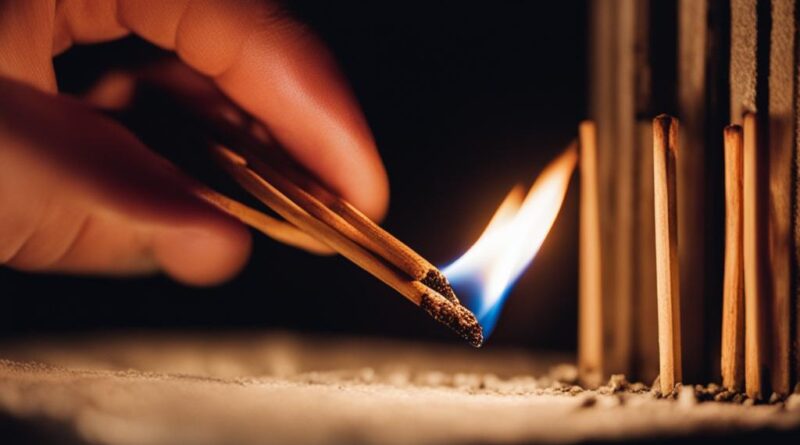Easy Guide on How to Light Furnace Pilot – Safe & Efficient
Are you experiencing a chilly home and suspect that your furnace pilot light may be out? Don’t worry, relighting it is a straightforward process that you can do yourself. By following a few simple steps, you can ensure that your furnace is safe, efficient, and back to keeping you warm and cozy. Read on to learn how to light your furnace pilot safely and efficiently.
Key Takeaways:
- Relighting your furnace pilot light is a DIY task that can be done safely and efficiently.
- Make sure to turn off the power and gas supply before attempting to relight the pilot light.
- Wait for the gas to dissipate before locating and lighting the pilot.
- Hold the reset button while igniting the pilot light.
- Finally, turn on the furnace and ensure it is functioning properly.
Understanding the Pilot Light and Its Purpose
The pilot light is a crucial component of a gas furnace. It is a small gas flame that burns continuously, ready to ignite the main burner when the thermostat calls for heat. This continuous flame ensures that the furnace can quickly produce heat when needed, providing comfort and warmth in your home.
When the temperature in the room falls below the set temperature on the thermostat, it sends a signal to the furnace to turn on. The pilot light then ignites the gas in the burners, which in turn heats up the air that circulates throughout your home. Without the pilot light, the gas in the burners would not ignite, and your furnace would not be able to produce heat.
The main burner is responsible for producing the heat that warms up the air in your home. It is ignited by the pilot light and continues to burn until the desired temperature is reached. Once the temperature is reached, the thermostat signals the furnace to turn off, and the pilot light remains lit, ready to ignite the burner again when needed.
Understanding the pilot light and its purpose is essential for maintaining the functionality and efficiency of your gas furnace. By ensuring that the pilot light is always lit and functioning correctly, you can have peace of mind knowing that your furnace will provide reliable heat when you need it.
Purpose of the Pilot Light
| Pilot Light | Main Burner |
|---|---|
| Small gas flame that burns continuously | Produces heat when ignited by the pilot light |
| Ignites the gas in the burners | Heats up the air that circulates throughout the home |
| Ensures safety, efficiency, and comfort | Produce reliable heat |
Reasons for Pilot Light Going Out
The pilot light in a gas furnace can sometimes go out due to various reasons. Understanding these causes can help you troubleshoot and resolve the issue effectively. Here are some common factors that may cause your pilot light to go out:
- Gas shut off: If the gas supply to your furnace is shut off for any reason, it will result in the pilot light going out.
- Airflow issues: Leaks in ducts or damage to the flue/chimney can disrupt the airflow, causing the pilot light to extinguish.
- Loose thermocouple: The thermocouple is a safety device that senses the presence of a pilot flame. If it becomes loose or faulty, it can lead to the pilot light going out.
- Dirty furnace: A dirty furnace can have a clogged pilot orifice, obstructing the flow of gas and causing the pilot light to go out.
These are the primary reasons why your pilot light may go out. By identifying the specific cause, you can take appropriate measures to relight the pilot or seek professional assistance if needed.
“A gas furnace pilot light is like a small fire that needs to be constantly fueled to ensure the functioning of your furnace. If the pilot light goes out, it’s crucial to investigate the root cause and address it promptly to restore warmth and comfort in your home.”
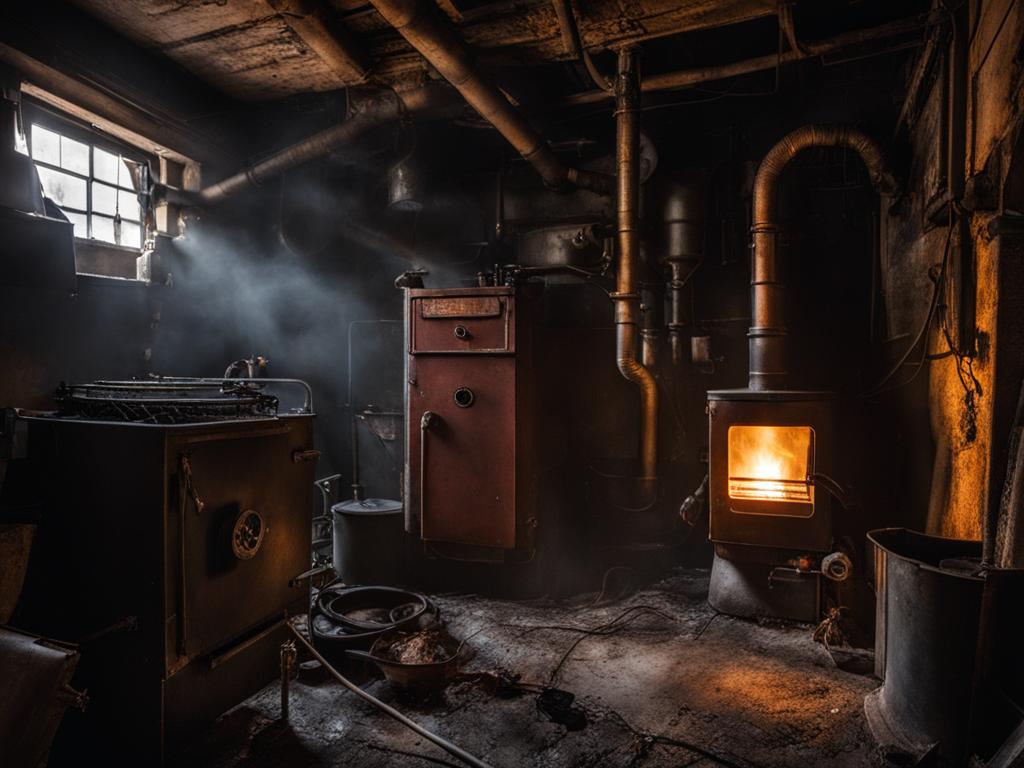
Pilot Light Going Out – Troubleshooting Tips
If you encounter the problem of a pilot light going out, here are some steps you can follow:
- Check the gas supply: Ensure that the gas supply to your furnace is turned on and not interrupted.
- Inspect the airflow: Look for any leaks or damage in the ductwork and ensure that the flue/chimney is clear of any obstructions.
- Tighten the thermocouple: If the pilot light goes out frequently, check if the thermocouple is loose and tighten it if necessary.
- Clean the furnace: Regularly clean your furnace, paying attention to the pilot orifice to prevent clogging.
By following these troubleshooting tips, you can resolve common issues associated with a pilot light going out and ensure the proper functioning of your gas furnace.
Step-by-Step Guide to Relighting Your Furnace Pilot Light
If your furnace pilot light has gone out, you can follow these simple steps to safely relight it. Remember to prioritize safety and take the necessary precautions before proceeding.
Step 1: Turn off the furnace: Before attempting to relight the pilot light, you must first turn off the furnace. This will help prevent any accidents or gas leaks.
Step 2: Locate the gas valve: Once the furnace is off, locate the gas valve. This valve is usually located near the bottom of the furnace and has three positions: “on,” “off,” and “pilot.”
Step 3: Switch to the “pilot” position: Turn the gas valve to the “pilot” position. This will allow the gas to flow to the pilot light.
Step 4: Hold the reset button: While in the “pilot” position, locate the reset button. It is typically found near the gas valve. Press and hold the reset button down.
Step 5: Light the pilot light: With the reset button held down, use a match or lighter to ignite the pilot light. Hold the flame near the pilot burner while keeping the reset button pressed.
Step 6: Turn on the gas and furnace: After the pilot light is lit, continue to hold the reset button for about 30 seconds. This allows the thermocouple to heat up and signal the furnace to stay on. Release the reset button and turn the gas valve back to the “on” position. Finally, turn on the furnace and ensure it is functioning properly.
Following these steps will help you safely relight your furnace pilot light and restore heat to your home. If you encounter any difficulties or are unsure about any part of the process, it is best to contact a professional HVAC technician for assistance.
| Step | Description |
|---|---|
| Step 1 | Turn off the furnace |
| Step 2 | Locate the gas valve |
| Step 3 | Switch to the “pilot” position |
| Step 4 | Hold the reset button |
| Step 5 | Light the pilot light |
| Step 6 | Turn on the gas and furnace |
Safety Tips for Relighting Your Furnace Pilot Light
When it comes to relighting your furnace pilot light, safety should always be your top priority. Follow these essential safety tips to ensure a smooth and accident-free process:
- Turn off the furnace: Before attempting to relight the pilot light, make sure to turn off the furnace completely. This will prevent any potential gas leaks or accidents.
- Wait for the gas to disperse: Give the gas enough time to dissipate before relighting the pilot light. This will help eliminate the risk of a sudden flare-up or explosion.
- Use caution when relighting: When using a match or lighter to relight the pilot light, keep your hands and other objects away from the flame. Be mindful of your surroundings and avoid any flammable materials.
- Avoid injuries: If you encounter any difficulties or feel uncomfortable during the process, it is best to seek professional assistance. Trying to relight the pilot light when unsure can lead to injuries or further damage to your furnace.
“Safety is paramount when it comes to relighting your furnace pilot light. By following these tips, you can ensure a smooth and accident-free process, keeping your home and loved ones safe and warm.”
Remember, if you are ever uncertain or face any challenges during the relighting process, it is always best to reach out to a professional HVAC technician. They have the expertise and experience to handle any complications and ensure the safety and efficiency of your furnace.
Table: Safety Tips for Relighting Your Furnace Pilot Light
| Safety Tips |
|---|
| Turn off the furnace |
| Wait for the gas to disperse |
| Use caution when relighting |
| Avoid injuries |
Common Signs that Your Furnace Pilot Light Needs Relighting
If your furnace pilot light goes out, there are several signs that indicate it needs to be relit. Recognizing these signs can help you troubleshoot the issue and ensure your furnace is operating safely and efficiently.
One of the most obvious signs that your furnace pilot light needs relighting is the absence of heat. If you turn on your furnace and there is no warm air coming from the vents, it is likely that the pilot light is not lit. Similarly, if you feel cold air coming from the vents instead of warm air, it could be an indication that the pilot light has gone out.
Another sign to watch out for is the smell of gas. If you detect a strong gas smell near your furnace, it is important to act quickly. Turn off the furnace, open windows for ventilation, and avoid any open flames or sparks in the vicinity. This could be a safety hazard and may require professional assistance.
An additional sign that your furnace pilot light needs to be relit is a yellow burner flame. Normally, the flame should be blue with a small yellow tip. If the flame is entirely yellow or predominantly yellow, it indicates an issue with the combustion process and may be a result of a pilot light problem.
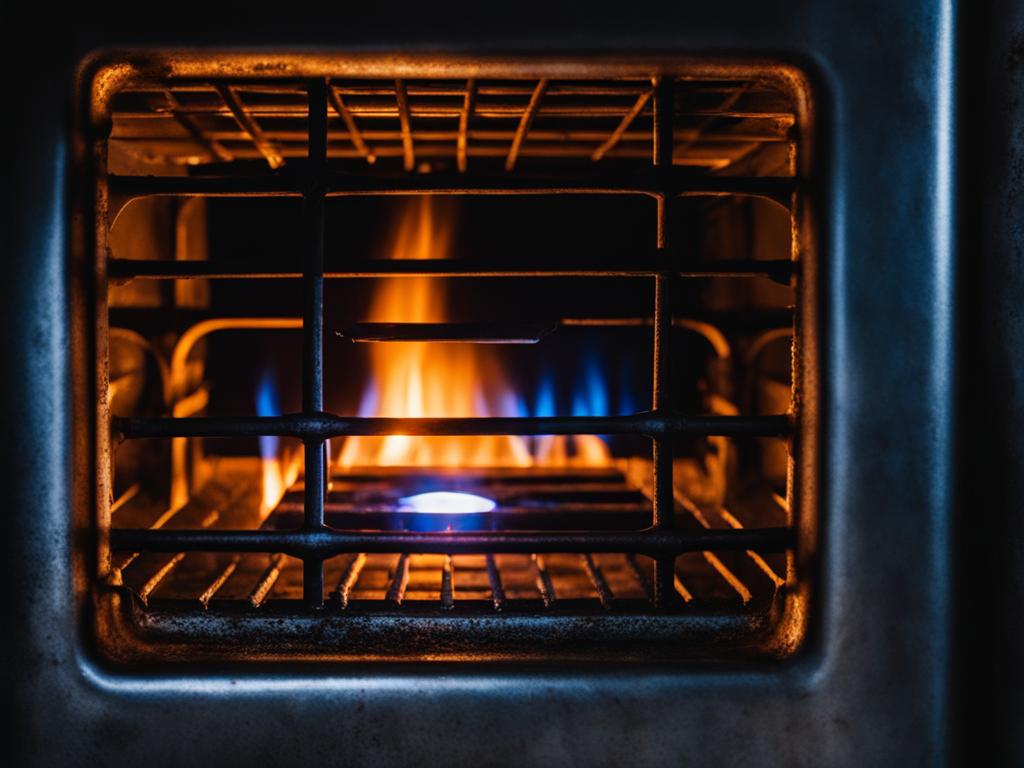
| Signs | Possible Causes |
|---|---|
| No heat | Pilot light is not lit |
| Cold air from vents | Pilot light is not igniting the main burner |
| Gas smell | Pilot light is not burning gas properly |
| Yellow burner flame | Combustion process issue |
These signs should not be ignored, as they can indicate a potential problem with your furnace. If you notice any of these signs, it is recommended to follow the steps outlined in this guide to safely relight your furnace pilot light or seek professional assistance if needed.
Time Duration and Warming Up After Relighting
After successfully relighting your furnace pilot light, it’s important to understand the time duration and the process of warming up your house. The time it takes to relight the pilot light is relatively quick, usually less than an hour. However, the duration for your house to warm up depends on the initial temperature.
If your house is already warm, it typically takes about 20-30 minutes for the heat to circulate and reach a comfortable level. However, if your house is cold, it may take up to an hour or more for the temperature to rise to a desirable level.
During this waiting period, you can utilize electric space heaters as an alternative heat source to provide additional comfort. These portable heaters are a practical solution for heating specific areas of your home while waiting for the furnace to warm up the whole house.
| Relighting Time | Duration to Warm Up | |
|---|---|---|
| Already Warm House | Less than an hour | 20-30 minutes |
| Cold House | Less than an hour | 1 hour or more |
It’s important to exercise caution during this time and ensure that the furnace is operating efficiently. Monitor the temperature in different areas of your home and make any necessary adjustments to maintain a comfortable environment.
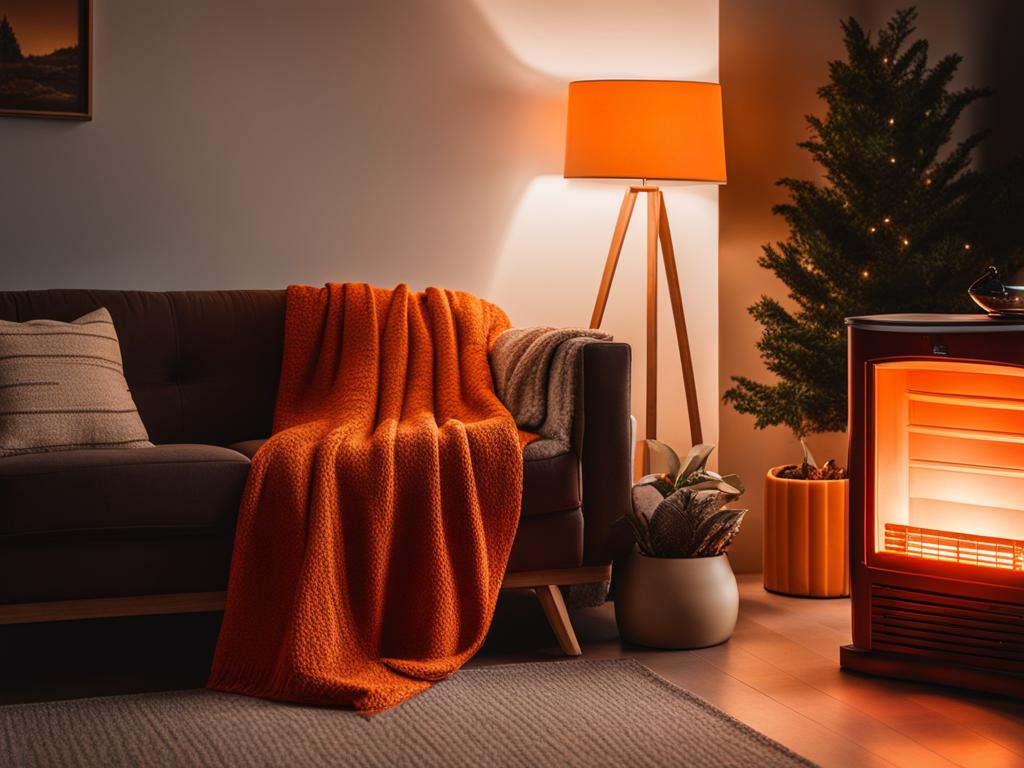
Safety Reminder: Heaters and Fire Hazards
When using electric space heaters, it’s crucial to follow safety guidelines to prevent fire hazards. Keep the heaters at least three feet away from any combustible materials such as curtains, furniture, or bedding. Never leave the heaters unattended or operate them while you’re sleeping.
Additionally, make sure to plug the heaters directly into outlets and avoid using extension cords, as they can overheat and cause a fire. Always turn off the heaters when they’re not in use and unplug them when you leave the room or go to sleep.
By understanding the relighting time and taking the necessary precautions, you can ensure the safe and efficient operation of your furnace while waiting for your house to warm up.
DIY or Professional Assistance for Relighting Pilot Light?
When it comes to relighting your furnace pilot light, you may be wondering whether to tackle it as a do-it-yourself (DIY) project or seek professional assistance. Both options have their advantages, and the choice ultimately depends on your comfort level and the complexity of the task at hand.
If you consider yourself handy and have experience with basic home maintenance tasks, relighting your pilot light can be a straightforward DIY project. By following the step-by-step guide provided earlier in this article, you can safely and efficiently relight your furnace pilot light. Remember to prioritize safety, turn off the power and gas supply, and use caution throughout the process.
However, if you’re unsure about working with gas or encounter any difficulties during the relighting process, it’s best to call a professional HVAC technician for assistance. They have the expertise and knowledge to handle any problems or safety concerns that may arise. A licensed technician can diagnose and resolve any underlying issues that may have caused the pilot light to go out in the first place, ensuring your furnace operates safely and efficiently.
“If you’re unsure about working with gas or encounter any difficulties during the relighting process, it’s best to call a professional HVAC technician for assistance.”
While DIY projects can be cost-effective, it’s important to prioritize safety and know your limits. If you’re uncertain about relighting your pilot light or have any concerns, it’s always better to seek professional assistance. Remember, your comfort and peace of mind are worth the investment in a qualified technician.
| DIY Relighting | Professional Assistance |
|---|---|
| Cost-effective | Expertise and knowledge |
| Suitable for basic home maintenance skills | Ensures safety and efficiency |
| Requires caution and adherence to instructions | Diagnoses and resolves underlying issues |
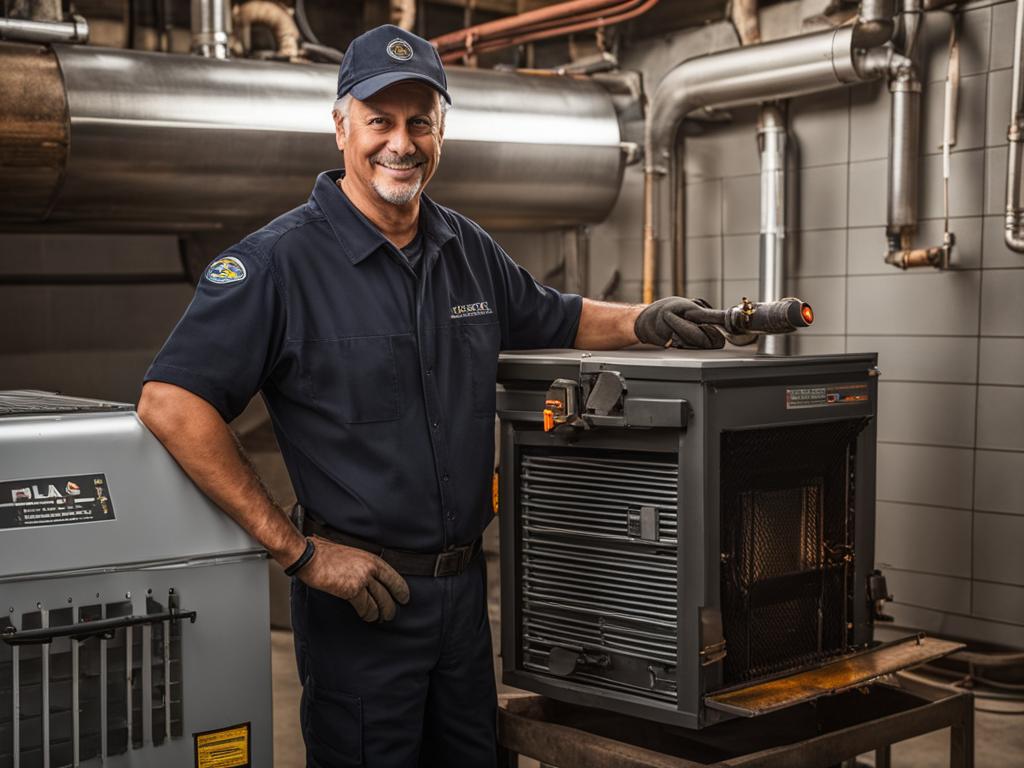
Conclusion
In conclusion, relighting your furnace pilot light is a straightforward process that can be safely and efficiently done by following the steps outlined in this guide. By prioritizing safety and taking the necessary precautions, you can ensure a warm and comfortable home throughout the winter season.
Remember to turn off the power and gas supply to your furnace before attempting to relight the pilot light. Allow the gas to dissipate and locate the pilot light. Carefully ignite the pilot light using a match or lighter while holding the reset button. Finally, turn on the furnace and ensure it is functioning properly.
If you encounter any difficulties or feel unsure about relighting the pilot light, it is highly recommended to seek professional assistance from an HVAC technician. They have the expertise to handle any issues or safety concerns that may arise during the process.
By following this relighting guide, you can maintain the safety and efficiency of your furnace pilot light, ensuring a cozy and reliable heating system for your home.
FAQ
What are the steps to safely relight a furnace pilot light?
To safely relight a furnace pilot light, start by turning off the power and gas supply to the furnace. Wait for the gas to dissipate, locate the pilot light, relight it using a match or lighter while holding the reset button, and then turn on the furnace to ensure it’s functioning properly.
What is the purpose of a pilot light in a gas furnace?
The pilot light in a gas furnace is a small gas flame that burns continuously to ignite the main burner when the thermostat calls for heat. It ensures the efficient and safe operation of the furnace by heating up the air that circulates throughout the home.
What are the common reasons for a pilot light going out?
Common causes of a pilot light going out include the gas supply being shut off, airflow issues caused by leaks or damage to the ducts or flue/chimney, a loose or faulty thermocouple, and a dirty furnace with a clogged pilot orifice.
How do I relight my furnace pilot light?
To relight your furnace pilot light, turn off the furnace and wait for a few minutes. Refer to the manufacturer’s instructions for specific guidance. Locate the gas valve and switch it to the “pilot” position. Hold down the reset button and use a long match or lighter to ignite the pilot light. Release the reset button once the pilot is lit and turn the gas valve to the “on” position. Finally, observe the furnace to ensure it’s working correctly.
What safety tips should I follow when relighting my furnace pilot light?
When relighting your furnace pilot light, prioritize safety by turning off the furnace and waiting for the gas to disperse. Use caution and keep your hands away from the flame when lighting the pilot. If unsure or encountering difficulties, it’s best to contact a professional HVAC technician for assistance.
What are the signs that indicate my furnace pilot light needs relighting?
Signs that your furnace pilot light needs relighting include the absence of heat, cold air coming from the vents, the smell of gas, and a yellow burner flame. If you notice any of these signs, it’s likely that your pilot light has gone out and needs to be relit.
How long does it take to relight a furnace pilot light and warm up a house?
Relighting the furnace pilot light usually takes less than an hour. After relighting, the duration for your house to warm up depends on the initial temperature. It typically takes 20-30 minutes to warm up a warm house and up to an hour or more for a cold house. In the meantime, you can use electric space heaters as an alternative heat source.
Should I attempt to relight the furnace pilot light myself or call a professional?
If you feel confident and follow the proper steps, you can attempt to relight the furnace pilot light as a DIY task. However, if you’re unsure or encounter any issues, it’s best to call a professional HVAC technician. They have the expertise to handle any problems or safety concerns that may arise.

